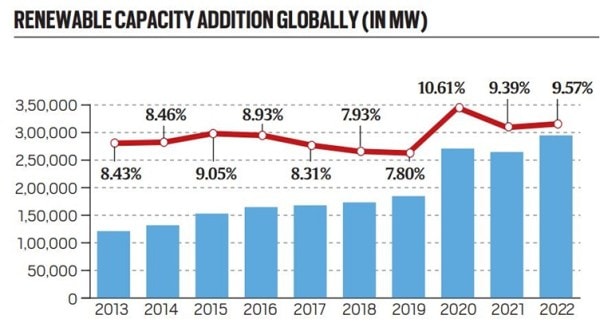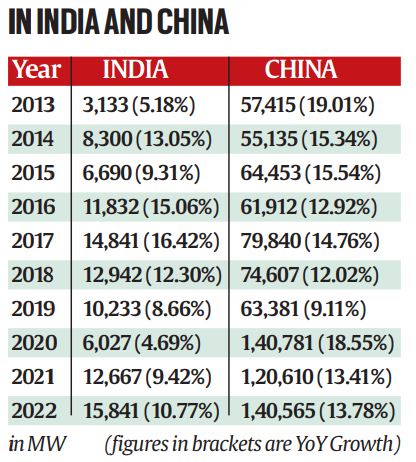G20: CLIMATE ACTION
1. Context
The only new and clear deliverable on climate action at the recent G20 summit was a commitment to work towards tripling global renewable energy capacity by 2030
According to an assessment by the International Energy Agency (IEA) earlier this year, this single measure could prevent 7 billion tonnes of carbon dioxide emissions by 2030. Not surprisingly, in the past few years, countries have been repeatedly urged to accept this as a goal
2.Renewable energy
- Renewable energy refers to energy that is generated from naturally replenishing sources and is considered environmentally friendly because it produces little to no greenhouse gas emissions or other harmful pollutants. These sources of energy are often referred to as "renewable" because they are naturally replenished on a human timescale, unlike fossil fuels which are finite and contribute to climate change
- Incidentally, tripling of renewable capacities was also among the lowest-hanging fruits available to the G20 grouping on the climate front, despite some initial reservations from traditional fossil fuel-producing countries like Russia and Saudi Arabia
- Renewable energy is already being deployed at a rapid pace across the world, with annual capacity additions growing by around 10% every year. And though the push no doubt came from the developed countries, there is no inherent objection to the deployment of renewable energy from the developing countries
- For countries like India and China, the growth of renewable energy is also the most preferred way to contribute to the global fight against climate change, and bring down the role of fossil fuels in their economies.

Source: International Renewable Energy Agency
- Tripling capacities within seven years is an ambitious task, nonetheless. The current global installed capacity of renewable energy is just short of 3,400 GW. In 2022, about 295 GW of new capacity was added, the highest ever.
- To triple the total capacity by 2030, the world would have to add nearly 1,000 GW of new capacity every year.
- That is what agencies like the International Renewable Energy Agency (IRENA) and the IEA, and climate activists and civil society organisations have been pushing for
- Tripling renewable capacity by 2030 is an ambitious, yet achievable goal. Annual capacity additions have more than doubled from 2015 to 2022, rising by about 11% per year on average

Source: International Renewable Energy Agency
3. International Solar alliance role renewable Energy
- As part of their climate action plans, about 135 countries have promised to create or enhance their renewable energy capacities, but as of now most of the new capacity addition is happening in a handful of large developing countries.
- India and China together account for more than 50% of global capacity additions in each of the last five years.
- In 2022, out of the 295 GW of additional capacity installed throughout the world, China alone added 140 GW, or nearly 48%.
- The tripling target cannot be achieved without the rapid growth in demand from other developing countries, mainly in Africa
- The addition of the African Union to the G20 is expected to provide the right impetus for this. Also, it is likely that this commitment will be adopted by the COP28 climate change meeting in Dubai this year, in which case it will have global ownership
- In 2022, out of the 295 GW of new renewable capacity created, 191 GW, or 65%, came from solar energy. The ISA was created specifically for the purpose of rapidly scaling up solar energy across the world, but it is still to realise its full potential
4. Funds regarding Climate Action
- The other big challenge, of course, is the availability of financial resources. According to an IRENA outlook, investments of about 5.3 trillion USD would be required per year, till 2050, to enable the energy transition that will limit the global rise in temperatures to within 1.5 degree Celsius from pre-industrial times.
- But even if the tripling target is achieved by 2030, it alone would not be sufficient for the 1.5 degree Celsius goal.
- According to current projections, the greenhouse gas emissions in 2030 would exceed the 1.5 degree Celsius compatible levels by about 24 billion tonnes of CO2 equivalent. Renewable energy, if tripled, would be able to avoid only 7 billion tonnes of CO2 equivalent, or less than one third of what is required.
- It is for this reason that many climate observers were disappointed with the G20 outcome
5. Way forward
he G20 meeting skirted most of the contentious issues greater emission cuts, phase-out of fossil fuels, massive mobilisation of financial resources and stuck to previously stated positions
G20 is not the forum where climate decisions are taken. That is the job of the climate change conferences called COPs. But with their heft and influence, G20 countries have the ability to galvanise global action. That is what the forum has decided to do with the promise on the renewable energy side
|
Previous Year Questions
1. Which one of the following is associated with the issue of control and phasing out of the use of ozone-depleting substance? (UPSC CSE 2015)
A.Bretton woods conference
B. Montreal Protocol
C. Kyoto Protocol
D. Nagoya Protocol
Answer (B)
|
Source: indianexpress




